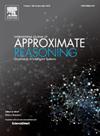FDACNet: Enhancing time-series classification with fuzzy feature and integrated self-attention and temporal convolution
IF 3
3区 计算机科学
Q2 COMPUTER SCIENCE, ARTIFICIAL INTELLIGENCE
引用次数: 0
Abstract
Time-series classification is crucial in time series analysis and holds significant importance in real-world scenarios. Applying self-attention and temporal convolution techniques is paramount when dealing with time series data. The self-attention mechanism enables the capture of correlations between different time steps in a sequence, thereby facilitating the handling of long-term dependencies. Meanwhile, temporal convolution is designed explicitly for processing time series data, effectively capturing temporal dependencies through convolutional layers. The integration of the two technologies plays a pivotal role in time series analysis, enabling accurate temporal classification. This paper proposes a novel net with fuzzy features and integrated self-attention and temporal convolution, denoted as FDACNet. The proposed net introduces two key components: FD-FE for fuzzy dominated feature extraction, and ATCmix for integrating self-attention and temporal convolution. FD-FE captures trend information by defining gradient relationship between time points within a time series sample. On the other hand, ATCmix combines convolution and self-attention to reduce parameters and enhance efficiency in handling time-series data. Finally, the proposed method is evaluated on twenty datasets and compared against twelve other state-of-the-art approaches. Experimental results demonstrate the superior classification accuracy of the proposed model, showcasing a 5.2% and 7.1% enhancement in average accuracy compared to the state-of-the-art convolution-based and transformer-based methods ModernTCN and iTransformer.
FDACNet:利用模糊特征,结合自关注和时间卷积增强时间序列分类
时间序列分类在时间序列分析中至关重要,在现实场景中具有重要意义。在处理时间序列数据时,应用自关注和时间卷积技术是至关重要的。自注意机制支持捕获序列中不同时间步之间的相关性,从而促进对长期依赖性的处理。同时,时间卷积被明确设计用于处理时间序列数据,通过卷积层有效捕获时间依赖性。两种技术的融合在时间序列分析中起着关键作用,实现了准确的时间分类。本文提出了一种集自关注和时间卷积于一体的模糊特征网络,称为FDACNet。该网络引入了两个关键组件:FD-FE用于模糊主导特征提取,ATCmix用于集成自关注和时间卷积。FD-FE通过定义时间序列样本中时间点之间的梯度关系来捕获趋势信息。另一方面,ATCmix将卷积和自关注相结合,减少了参数,提高了处理时间序列数据的效率。最后,该方法在20个数据集上进行了评估,并与其他12种最先进的方法进行了比较。实验结果表明,所提出的模型具有较高的分类精度,与基于卷积和基于变压器的方法相比,平均准确率分别提高了5.2%和7.1%。
本文章由计算机程序翻译,如有差异,请以英文原文为准。
求助全文
约1分钟内获得全文
求助全文
来源期刊

International Journal of Approximate Reasoning
工程技术-计算机:人工智能
CiteScore
6.90
自引率
12.80%
发文量
170
审稿时长
67 days
期刊介绍:
The International Journal of Approximate Reasoning is intended to serve as a forum for the treatment of imprecision and uncertainty in Artificial and Computational Intelligence, covering both the foundations of uncertainty theories, and the design of intelligent systems for scientific and engineering applications. It publishes high-quality research papers describing theoretical developments or innovative applications, as well as review articles on topics of general interest.
Relevant topics include, but are not limited to, probabilistic reasoning and Bayesian networks, imprecise probabilities, random sets, belief functions (Dempster-Shafer theory), possibility theory, fuzzy sets, rough sets, decision theory, non-additive measures and integrals, qualitative reasoning about uncertainty, comparative probability orderings, game-theoretic probability, default reasoning, nonstandard logics, argumentation systems, inconsistency tolerant reasoning, elicitation techniques, philosophical foundations and psychological models of uncertain reasoning.
Domains of application for uncertain reasoning systems include risk analysis and assessment, information retrieval and database design, information fusion, machine learning, data and web mining, computer vision, image and signal processing, intelligent data analysis, statistics, multi-agent systems, etc.
 求助内容:
求助内容: 应助结果提醒方式:
应助结果提醒方式:


